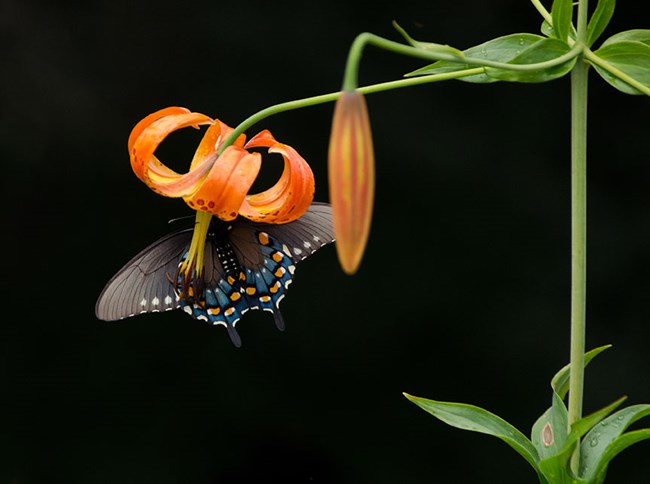
Kristina Plaas photo 
Kristina Plaas photo Spanning the Southern and Central Appalachians, the Blue Ridge Parkway offers an exceptional glimpse of Appalachian flora, which is world renown for its diversity. Over 1,400 species of vascular plants are known to occur in the park, though this number may approach 2,000 species as the park begins an extensive inventory of all plants and animals.
The flora of the Blue Ridge Parkway is diverse for a number of reasons, such as climatic variability, large north-south geographic range, diverse geologic substrate, and many different micro-habitats. Because of the wide range in elevation from high peak to low valley, the park visitor can enjoy a tremendous variety of wildflowers and blooming shrubs throughout the spring, summer, and fall months. While the summer wildflowers are blooming in the valleys, the spectacular spring wildflowers are just beginning to bloom on the high peaks.
The Blue Ridge Parkway is unique in that it covers a wide range of habitats along the north-south axis of the Appalachian Mountains, such that the flora on a mountain summit at the northern end of the park may be quite different from the flora of a mountain summit at the southern end. Some of these habitats are exceptionally rare in the region and a few are even globally rare. An example includes rock outcrops at high elevations, which contain a fragile group of alpine species that were pushed southward during glacial times and eventually were left stranded on the southern mountains. The main threat to this fragile plant community is trampling by unaware park visitors. Another unique habitat is the Grassy Balds which were likely grazed by native animals such as bison and elk, but which now are maintained by park biologists. . Download a bloom calendar before you head out on your next Parkway adventure. The bloom calendar highlights some of the many wildflowers and blooming shrubs and trees along the route. The calendar organizes the plant by months of typical seasonal bloom and include common and scientific names, bloom color, and habitat. Bloom peak can vary each year, but generally bloom times are earlier in Virginia and at lower elevations than at higher elevations in North Carolina. Many blooms listed on the calendar include a link to a photo to help with identification. While viewing the attached file on your computer screen, hover over the common name to see if a link appears.

Peter Hamel photo The same environmental variability that leads to such spectacular bloom displays in the spring and summer also contributes to autumn leaf color. The first leaves to change are those of deciduous trees on the highest elevations, which change to vivid shades of orange, red, yellow, and purple. Throughout the month of October the leaf color changes gradually, beginning in the high mountains and concluding at the lower slopes and valleys. |
Last updated: August 14, 2024
